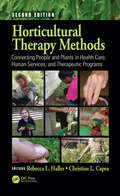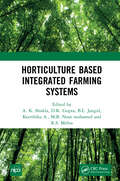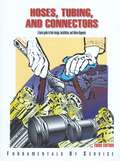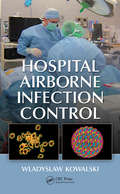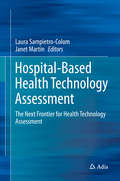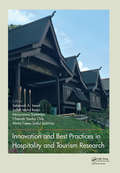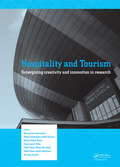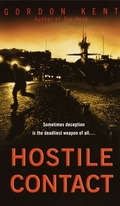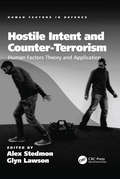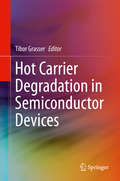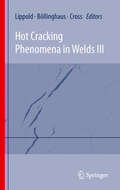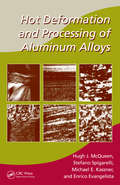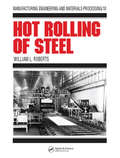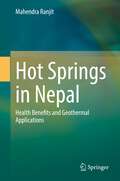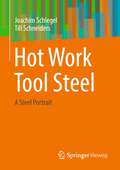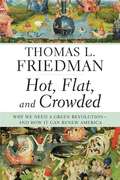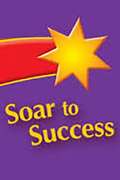- Table View
- List View
Horticultural Therapy Methods: Connecting People and Plants in Health Care, Human Services, and Therapeutic Programs, Second Edition
by Rebecca L. Haller Christine L. CapraHorticultural therapy has evolved from its use only by volunteer gardeners to become a recognized and respected therapeutic modality conducted by trained, registered professionals. Horticultural Therapy Methods is the first textbook to describe the processes and techniques used to provide horticultural therapy interventions and the rationale for their use. This book presents types of programs, settings, and goals in horticultural therapy. It outlines treatment planning; development of sessions to meet treatment objectives; motivation and behavior management techniques; documentation guidelines; practical approaches for wellness; and resources for activity ideas. New to this Edition: Various useful examples of horticultural therapy in practice and strategically placed tips and resources. Additions to appendix on horticultural therapy treatment strategies. New chapter on session planning. Thirty-seven photographs demonstrating horticultural therapy in practice. Additional "HT Practice" examples and tips. The book is used as a reference and a guide for students, educators, and those conducting horticultural therapy or therapeutic horticulture to guide them in constructing effective treatment programs. Health care and human service professionals use the reference in the therapy, treatment, and education of inmates, residents, patients, trainees, students, and other participants.
Horticulture Based Integrated Farming Systems
by A. K. Shukla D. K. Gupta B. L. Jangid Keerthika A. R. S. Mehta M.B. Noor mohamedThe content of this book provides information on advanced knowledge in the sphere of importance and scope of horticulture in India, horticulture based integrated farming systems, integration of livestock in horticulture based farming systems, emerging issues, natural resource management, disease and pest management, organic farming and certification, post-harvest measures and value addition in arid fruits and vegetables, marketing aspects, status and export promotion measures and procedures. Note: T&F does not sell or distribute the hardback in India, Pakistan, Nepal, Bhutan, Bangladesh and Sri Lanka. This title is co-published with NIPA.
Hoses, Tubing, And Connectors: A Guide to Their Design, Installation, and Failure Diagnosis (Fundamentals of Service)
by John DeereHoses, Tubing and Connectors is the definitive how-to book when it comes to this subject - from showing you how to diagnose problems and test for failed parts, to explaining how to repair the part, to showing how to install the repaired or new part. And when we say show you, we mean just that. Our book is filled with illustrations to clearly demnstrate what must be done... photographs, drawings, pictorial diagrams, and troubleshooting charts. This book discusses conductors- paths to direct flow of fluids and gases. Hoses, pipes, tubing, and connectors are the vital link between components within machine systems. Instructions are written in simple language so that they can be easily understood. Starting with the basic design of each type of conductor, the book moves through how to select each type to how to test for failures, and ends with how to repair and maintain the different kinds. This book can be used by anyone, from a novice to an experienced mechanic. Hoses, Tubing and connectors easily helps a reader to understand hoses, pipes, tubing, and connectors better. By starting with the basics, it builds your knowledge step by step in a very structured manner.
Hospital Airborne Infection Control
by Wladyslaw KowalskiAlthough nosocomial, or hospital-acquired, infections have been well cataloged and are fairly well understood, traditional solutions have failed to completely eliminate the problem. Even the most modern hospitals find themselves stymied by the persistence of these pathogens in hospital wards and operating rooms. The degree to which most of these in
Hospital-Based Health Technology Assessment
by Laura Sampietro-Colom Janet MartinA timely work describing how localized hospital-based health technology assessment (HB-HTA) complements general, 'arms-length' HTA agency efforts, and what has been the collective global impact of HB-HTA across the globe. While HB-HTA has gained significant momentum over the past few years, expertise in the field, and information on the operation and organization of HB-HTA, has been scattered. This book serves to bring this information together to inform those who are currently working in the field of HTA at the hospital, regional, national or global level. In addition, this book is intended for decision-makers and policy-makers with a stake in determining the uptake and decommissioning of new and established technologies in the hospital setting. HTA has traditionally been performed at the National/Regional level by HTA Agencies, typically linked to governments. Yet hospitals are the main entry door for most health technologies (HTs). Hospital decision-makers must undertake multiple high stakes investment and disinvestment decisions annually for innovative HTs, usually without adequate information. Despite the existence of arms-length HTA Agencies, inadequate information is available to hospital decision-makers either because relevant HTA reports are not yet released at the time of entry of new technologies to the field, or because even when the report exists, the information contained is insufficient to clarify the contextualized informational needs of hospital decision makers. Therefore, there has recently been a rising trend toward hospital-based HTA units and programs. These units/programs complement the work of National/Regional HTA Agencies by providing the key and relevant evidence needed by hospital decision makers in their specific hospital context, and within required decision-making timelines. The emergence of HB-HTA is creating a comprehensive HTA ecosystem across health care levels, which creates better bridges for knowledge translation through relevance and timeliness.
Hospitality and Tourism 2015: Proceedings of HTC 2015 (Malacca, Malaysia, 2-3 November 2015)
by Salleh Mohd Radzi Norzuwana Sumarjan Salamiah A. Jamal Mohd Faeez Saiful Bakhtiar Chemah Tamby ChikInnovation and Best Practices in Hospitality and Tourism Research contains 71 accepted papers from the Hospitality and Tourism Conference (HTC 2015, Melaka, Malaysia, 2-3 November, 2015). The book presents theup-and-coming paradigms and innovative practices within the hospitality and tourism industries, and covers the following topics:Mana
Hospitality and Tourism: Synergizing Creativity and Innovation in Research
by Salleh Mohd Radzi Norzuwana Sumarjan Zurinawati Mohi Mohd Salehuddin Mohd Zahari Mohd Hafiz Mohd Hanafiah Mohd Faeez Saiful Bakhtiar Artinah ZainalHospitality and Tourism - Synergizing creativity and innovation in research contains 116 accepted papers from the International Hospitality and Tourism Postgraduate Conference 2013 (Shah Alam, Malaysia, 2 3 September 2013). The book presents trends and practical ideas in the area of hospitality and tourism, and is divided into the sections below:-
Host
by Peter JamesHow far would you go to live forever?Brilliant scientist Joe Messenger believes that people can be made to live for ever. Knowing the human body can be frozen indefinitely, Joe devises a way of downloading the human brain into a supercomputer called ARCHIVE. But Joe's wife, Karen, is worried by his preoccupation with ARCHIVE, which seems to be developing signs of a distinct and sinister personality of its own.Then, just as Joe is on the brink of a scientific breakthrough, a series of macabre accidents befall him and his family - and Joe finds himself facing the terrifying consequences of his own obsessions.'Easily James's best book to date; a thought-provoking menacer that's completely technological and genuinely frightening about the power of future communications.' Time Out'Compulsive ... I cannot remember when I last read a novel I enjoyed so much.' Sunday TelegraphRead more from the multi-million copy bestselling author of the Roy Grace novels:Possession DreamerSweet Heart Twilight Prophecy Alchemist Denial The Truth * Each Peter James novel can be read as a standalone*
Host
by Peter JamesHow far would you go to live forever?Brilliant scientist Joe Messenger believes that people can be made to live for ever. Knowing the human body can be frozen indefinitely, Joe devises a way of downloading the human brain into a supercomputer called ARCHIVE. But Joe's wife, Karen, is worried by his preoccupation with ARCHIVE, which seems to be developing signs of a distinct and sinister personality of its own.Then, just as Joe is on the brink of a scientific breakthrough, a series of macabre accidents befall him and his family - and Joe finds himself facing the terrifying consequences of his own obsessions.'Easily James's best book to date; a thought-provoking menacer that's completely technological and genuinely frightening about the power of future communications.' Time Out'Compulsive ... I cannot remember when I last read a novel I enjoyed so much.' Sunday TelegraphRead more from the multi-million copy bestselling author of the Roy Grace novels:Possession DreamerSweet Heart Twilight Prophecy Alchemist Denial The Truth * Each Peter James novel can be read as a standalone*
Hostile Contact (Alan Craik)
by Gordon KentWith twists as harrowing as a high-g-force turn, Hostile Contact is vintage Gordon Kent: an electrifying blend of military suspense and espionage thriller. In it, Navy intelligence officer Alan Craik returns to action, strapping himself in for a wild ride into a dangerous, borderless realm of spies, counterspies, and high-tech warfare on both sides of a potentially lethal conflict--between China and the U.S.A. Hostile Contact When Alan Craik and NCIS agent Mike Dukas spearheaded a hunt for a traitor inside the CIA, they landed in the middle of a firefight--and made some very powerful enemies. Inside Washington, some still worship the arch spy Craik and Dukas took down--and now these men are plotting their revenge. With their expertise in counterespionage, Craik and Dukas have been lured into an operation that will put them in contact with the Chinese, an operation with only one real purpose: to destroy them both. But while they know better than to take anything at face value, Craik and Dukas cannot guess how another player will shape the game. Their contact in Jakarta is a Chinese double agent walking a high wire between his handlers, as the Chinese search for a mother lode of money lost on the covert battlefield.Craik is also holding down his day job, flying a sub hunter S-3B crammed with high-tech gear off the coast of the Pacific Northwest. Along with his astronaut-to-be wife, Rose, Craik and his team are acting on intercepts of a “ghost” radio whose purpose they can only guess. Craik's expertise in intelligence tells him to start searching for an unseen, unknown submarine that may be lurking off Whidbey Island--with the ability to strike a death blow against the Navy's most important missile-loaded subs. Suddenly Craik is thrust into a secret war raging from the heart of Beijing to the depths of the Pacific, as espionage and sub hunting come together in a chase to rescue a Chinese defector and his family, while a U.S. Navy carrier group is threatened by hostile suicide boats acting on targeting information from a submarine.
Hostile Intent and Counter-Terrorism: Human Factors Theory and Application (Human Factors in Defence)
by Glyn Lawson Alex StedmonThis volume presents world-leading ideas and research that explores some of the most prominent topics relevant to detecting terrorism. The book is divided into six key themes: conceptualising terrorism, deception and decision making, social and cultural factors in terrorism, modelling hostile intent, strategies for counter-terrorism, and future directions. Twenty two chapters cover the spectrum of detecting terrorist activities, hostile intent, crowded public spaces and suspicious behaviour. The work draws from high impact research findings and presents case-studies to help communicate concepts. Specific areas of interest include methodological issues in counter-terrorism, counter terrorism policy and its impact on end users, novel research methods and innovative technologies in counter-terrorism. A variety of disciplines are represented by this work, including: ergonomics/human factors, psychology, criminology, cognitive science, sociology, political theory, art/design, engineering and computer science. This book not only expands the knowledge base of the subject area and is therefore of prime relevance to researchers investigating counter-terrorism, but provides a valuable resource to security stakeholders at policy and practitioner levels.
Hosting Capacity for Smart Power Grids
by Ahmed F. Zobaa Paulo F. Ribeiro Shady H. E. Abdel Aleem Sherif M. IsmaelThis book brings together several aspects of hosting capacity (HC) assessment and enhancement of modern electrical power systems, HC is a key enabler for affordable, reliable and renewable energy sources, that will aid in transitioning away from traditional high-carbon energy sources. The chapters provide insight into the state of the art on current hosting capacity concepts, restrictive performance limits, distribution network operators and network planners’ viewpoints, and the cutting-edge technologies deployed worldwide for hosting capacity enhancement. Written by leading experts in power, control, and renewable energy resources. This book is beneficial to distribution system operators, network planners, distribution generation investors, and researchers in this field. Due to its broad scope, it is an ideal resource for students in advanced graduate-level courses and special topics in the field of hosting capacity assessment and enhancement in modern electrical power systems.
Hot Carrier Degradation in Semiconductor Devices
by Tibor GrasserThis book provides readers with a variety of tools to address the challenges posed by hot carrier degradation, one of today's most complicated reliability issues in semiconductor devices. Coverage includes an explanation of carrier transport within devices and book-keeping of how they acquire energy ("become hot"), interaction of an ensemble of colder and hotter carriers with defect precursors, which eventually leads to the creation of a defect, and a description of how these defects interact with the device, degrading its performance.
Hot Coal, Cold Steel: Russian and Ukrainian Workers from the End of the Soviet Union to the Post-communist Transformations
by Stephen CrowleyWell after the disintegration of the Communist Party and the Soviet state--and through several years of economic collapse--industrial workers in almost every sector of the former Soviet Union have remained quiescent and the same ineffective and unpopular trade unions still hold a virtual monopoly on worker's representation. Why? While many argue that labor is a central variable in the development of economic and political systems, little is known about workers in the states of the former Soviet Union since the fall of Communism. In a comparative study of two groups of industrial workers--the coal miners and steelworkers--at the end of the Soviet era, Stephen Crowley sheds light on where these workers have been and where they are going. Coal miners in the final years of the Soviet Union effectively organized and led strikes which supported the end of Communism, even though their heavy subsidies would be threatened by capitalism. Steel workers, in contrast, did not effectively organize and strike. This pattern has continued under the new governments, with the coal miners effectively organized and seeking protection from the worst consequences of marketization, while the steel workers remain weakly organized despite deteriorating economic conditions. Based on extensive on-site research including interviews with miners and steelworkers, labor leaders and plant managers, Crowley develops a detailed picture of the conditions under which workers organize. His findings have application beyond the conditions of post-Communist Russia and Ukraine to other societies undergoing fundamental change.
Hot Cracking Phenomena in Welds III
by Thomas Böllinghaus Carl E. Cross John LippoldThis is the third in a series of compendiums devoted to the subject of weld hot cracking. It contains 22 papers presented at the 3rd International Hot Cracking Workshop in Columbus, Ohio USA in March 2010. In the context of this workshop, the term "hot cracking" refers to elevated temperature cracking associated with either the weld metal or heat-affected zone. These hot cracking phenomena include weld solidification cracking, HAZ and weld metal liquation cracking, and ductility-dip cracking. The book is divided into three major sections based on material type; specifically aluminum alloys, steels, and nickel-base alloys. Each of these sections begins with a keynote paper from prominent researchers in the field: Dr. Sindo Kou from the University of Wisconsin, Dr. Thomas Böllinghaus from BAM and the University of Magdeburg, and Dr. John DuPont from Lehigh University. The papers contained within include the latest insight into the mechanisms associated with hot cracking in these materials and methods to prevent cracking through material selection, process modification, or other means. The three Hot Cracking Phenomena in Welds compendiums combined contain a total of 64 papers and represent the best collection of papers on the topic of hot cracking ever assembled.
Hot Deformation and Processing of Aluminum Alloys (Manufacturing Engineering and Materials Processing)
by Hugh J. McQueen Stefano Spigarelli Michael E. Kassner Enrico EvangelistaA comprehensive treatise on the hot working of aluminum and its alloys, Hot Deformation and Processing of Aluminum Alloys details the possible microstructural developments that can occur with hot deformation of various alloys, as well as the kind of mechanical properties that can be anticipated. The authors take great care to explain and differenti
Hot Rolling of Steel (ISSN #Vol. 10)
by William L. RobertsNumber ten of the Manufacturing Engineering and Material Processing series. Includes one page corrigenda laid-in. 800 illustrations clarifying key points. Thorough account of the hot-rolling process and facilities as well as follow-up treatments given to hot-rolled products. Companion volume to Cold Rolling of Steel by William Roberts circa 1978
Hot Springs in Nepal: Health Benefits and Geothermal Applications
by Mahendra RanjitThis book presents a profile of the majority of hot springs in and around tourist destinations in Nepal. In particular, there is a focus on Pokhara, Jumla, the world- famous Annapurna region, Ruby Valley, and Api Nampa Conservation Area. The chapter on health benefits of mineral hot springs provides a history of hot springs supported by a literature review and case study. Further chapters explore the direct uses of geothermal energy for various purposes and power generation, together with a section on conventional hydrothermal resources. This book is of interest to the general public, students, national and international researchers, energy planners, and health professionals. The book is a valuable tool for sociologists who want to gain insight into the cultural and religious aspects of hot water mineral springs.
Hot Work Tool Steel: A Steel Portrait
by Joachim Schlegel Till SchneidersThe world of steel is amazingly diverse and so complex that it is not easy to keep track of in practice. In the form of portraits of selected steels and steel groups, this world of steel is to be brought closer to the reader; compact, understandable, informative, structured with examples from practice and suitable for reference. Hot work tool steels are a group of alloyed steels with high hot strength suitable for tools. These can withstand surface temperatures of more than 600 °C in use. For this purpose, they are optimally adapted to the most diverse requirements, especially for tools used in hot forming and die casting. Important are the chemical compositions, methods of production and processing as well as their properties or the material data of hot work tool steels, which are briefly and clearly presented in this book. The contents· The history of hot work tool steels· Designations, chemical compositions, grades, microstructure and properties· Production (melting and powder metallurgy), heat and surface treatments The target groups Trainees in metal professionsStudents, practitioners, engineers in steel production, forming and production technology, in steel, metal and tool construction and in the steel trade
Hot, Flat, and Crowded: Why We Need a Green Revolution - and How It Can Renew America
by Thomas L. FriedmanFriedman shows how the 2 biggest crises of today (America's loss of focus since 9/11 and the global environment crisis) are linked and how we can restore the world and revive America at the same time
Hotel Dreams: Luxury, Technology, and Urban Ambition in America, 1829–1929 (Studies in Industry and Society)
by Molly W. BergerWinner, 2012 Sally Hacker Prize, Society for the History of TechnologyHotel Dreams is a deeply researched and entertaining account of how the hotel's material world of machines and marble integrated into and shaped the society it served. Molly W. Berger offers a compelling history of the American hotel and how it captured the public's imagination as it came to represent the complex—and often contentious—relationship among luxury, economic development, and the ideals of a democratic society.Berger profiles the country's most prestigious hotels, including Boston's 1829 Tremont, San Francisco's world-famous Palace, and Chicago's enormous Stevens. The fascinating stories behind their design, construction, and marketing reveal in rich detail how these buildings became cultural symbols that shaped the urban landscape.
Hotel Law: Transactions, Management and Franchising
by Nelson MigdalHotel Law, Transactions, Management and Franchising presents a practical guide to the issues that face lawyers and industry leaders working in the hospitality field. It aims to develop the reader’s understanding of the acquisition process and the complex relationships in management and franchise deals that dominate the hotel industry. This text is written primarily as a desktop reference for legal practitioners working in the hotel law field and is also suitable for students studying towards hotel and hospitality careers both at an undergraduate and law school or graduate level. The highly experienced author, contributors and editors offer insights into the industry players and their preferred positions, desired outcomes, and the potential pitfalls that can ensnare even the most well-planned deals. With broad coverage of the rapidly growing field of hospitality law—including gaming, recreation, and amenities— the book’s approach examines the dominant models of hotel ownership, management and franchising, and includes independent hotels and the move towards complex resorts. The book’s coverage of key legal topics ranges from real estate, to intellectual property, contracts, and finance.Hotel Law will give readers an understanding of the hospitality industry from the perspective of the transactional practitioner, while examining the multi-party relationships and agreements that develop between an owner, operator, licensor and lender.
Hotels and Resorts: An investor's guide
by David HarperHotels and Resorts: An investor's guide presents a comprehensive analysis of how hotels, golf courses, spas serviced apartments, gyms and health clubs and resorts are developed, operate and are valued. Drawing on over 18 years’ experience in the leisure property industry, David Harper provides invaluable advice on how to buy, develop and sell such properties. Working through the required due diligence process for purchases, including how to identify a "good buy", through the "route map" for a successful development and ending with how to ensure you maximise your returns when selling the asset, this book covers the whole life-cycle of leisure property ownership. Examples of valuations, development issues and sales processes are taken from the USA, UK, France, Nigeria, Kenya, Australia, Hong Kong, Singapore and Brazil provide in depth analysis on the similarities and differences in approach to hotels and resorts in various parts of the world. This book provides invaluable guidance to international investors, developers, asset managers and students in related subject areas.
Hotshots!
by Chris L. DemarestSparks from a train ignite a field baked for days. Then winds whip it into a fast-running blaze. With fire now spreading out of control, the hotshots are called. They're ready to roll. What are hotshots?They are an elite ground fire-fighting corps of men and women highly trained to understand the scientific nature of fire in order to go deep into the heart of a wildfire, beyond the reach of hose lines, to limit the destruction of land and wildlife. As more homes are being built into the natural landscape, the role of the hotshot in fighting fire has become increasingly important. With stunning pictures and an action-packed text, fine artist and volunteer firefighter Chris L. Demarest here captures the spirit of the dedicated hotshots and the real-life drama of the dangerous work they must do every day.
House (How It's Built)
by Becky HerrickKids are fascinated by how things are constructed, especially big things!This brand-new STEM (science, technology, engineering, and mathematics) series will take readers on visits to various work sites so they can see exactly How It’s Built! Kids will follow along as a small group of fictional characters get to find out exactly what it takes to build things that they probably see all the time, like bridges, houses, boats, and cars, to things that they might dream of being inside, like skyscrapers and rockets.
